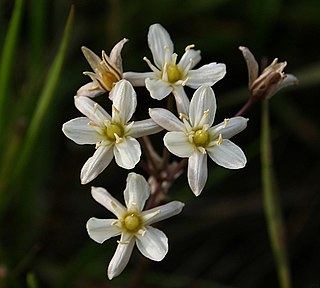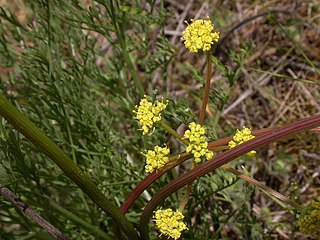
Limnanthes douglasii is a species of annual flowering plant in the family Limnanthaceae (meadowfoam) commonly known as Douglas' meadowfoam or poached egg plant. It is native to California and Oregon, where it grows in wet, grassy habitat, such as vernal pools and spring meadows. It can grow in poorly drained clay soils. The plant was collected by the Scottish explorer and botanist David Douglas, who worked on the west coast of America in the 1820s.

Limnanthes alba is a species of flowering plant in the meadowfoam family known by the common name white meadowfoam. It is native to California and Oregon, where it grows in wet grassy habitat, such as vernal pools and moist spots in woodlands. It generally grows in poorly drained soils. It is an annual herb producing an erect or decumbent stem up to about 30 centimeters long. The leaves divided into several lobed or unlobed leaflets. The flower is cup-shaped with white petals 1 to 1.5 centimeters long.

Limnanthes, the type genus of the family Limnanthaceae, consists of annual herbaceous plants commonly known as the meadowfoams. The seven species are all native to coastal and adjoining regions of western North America, where they typically grow in marshy habitats, such as the margins of vernal pools. Some are endemic to California.

Limnanthes vinculans, the Sebastopol meadowfoam, is an endangered species of meadowfoam found only in the Laguna de Santa Rosa in Sonoma County, California, United States and an area slightly to the south in the Americano Creek and Washoe Creek watersheds. The name vinculans derives from the Latin root vinculum, meaning "a bond, a cord." The specific epithet vinculans means linking or bonding, in reference to the sharing of some characters of L. vinculans with L. douglasii (R.Br) and L. bakeri.

Allium tuolumnense is a rare species of wild onion, known by the common name Rawhide Hill onion.
Blennosperma bakeri is a rare species of flowering plant in the daisy family known by the common names Baker's stickyseed and Sonoma sunshine.

Clarkia exilis is a small herbaceous annual plant of western North America. It is an uncommon species in the evening primrose family known by the common names Kern River clarkia and slender clarkia.

Clarkia williamsonii is a species of flowering plant endemic to California, where it is known from the forests and woodlands of the northern and central Sierra Nevada foothills.

Clarkia xantiana is a species of flowering plant in the evening primrose family known by the common name gunsight clarkia. It is endemic to California, where it is known from the southern Sierra Nevada and its foothills and the adjacent Transverse Ranges. This is an erect annual herb with linear to lance-shaped leaves each up to 6 centimeters long. The inflorescence produces opening flowers and closed buds. The sepals stay fused as the petals bloom from one side. Each petal is up to 2 centimeters long and generally light to medium purple in color, sometimes with a dark, ringed spot on the petals of the upper whorl. The petal has a narrow claw and a wider blade which has two lobes at the tip with a small tooth between.

Limnanthes floccosa, or woolly meadowfoam, is a species of meadowfoam found in Northern California and Southern Oregon, in the United States. Most of the subspecies have highly restricted distributions and are listed as critical or endangered.

Limnanthes bakeri is a rare species of meadowfoam known by the common name Baker's meadowfoam. It is endemic to Mendocino County, California, where it is known from only about 20 occurrences in the vicinity of Willits. It is a plant of wet, grassy habitat such as vernal pools and marshy spring meadows.
Limnanthes montana is a species of meadowfoam known by the common name mountain meadowfoam. It is endemic to the Sierra Nevada foothills of California, where it grows in wet, grassy habitat such as marshy spring meadows.

Muilla maritima is a species of flowering plant known by the common names sea muilla and common muilla. It is native to California and Baja California, where it grows in many types of habitats from the coast to the Mojave Desert and Sierra Nevada foothills and other inland mountains, in grassland, woodland, desert, and forest floras. It is a perennial plant growing from a corm and producing an erect flowering stem up to half a meter tall. The onion-like leaves at the base of the stem may be 60 centimeters long. The flowering stem bears an umbel-shaped array of many flowers on pedicels up to 5 centimeters long. Each flower has six tepals which are green-tinged white in color with brownish midribs and no more than 6 millimeters in length. At the center of the flower are six erect stamens with blue, green, or purplish anthers.
Nemophila pulchella, known by the common name Eastwood's baby blue-eyes, is a species of flowering plant in the borage family. It is endemic to California, where it is found from the San Francisco Bay Area to the southern Sierra Nevada to the Transverse Ranges. It grows in many types of mountain, foothill, and valley habitats.
Rupertia hallii is a species of flowering plant in the legume family known by the common name Hall's California tea, or Hall's rupertia. It is endemic to California, where it is known only from a small section of the northern Sierra Nevada foothills on the border between Butte and Tehama Counties. It is a perennial herb approaching a meter in height with slender, leafy branches. The leaves are each made up of three lance-shaped or oval, pointed leaflets measuring up to 9 centimeters long. The inflorescence is a clustered raceme of several whitish or yellowish pealike flowers. Each flower has a tubular calyx of sepals and a corolla spreading to about a centimeter in width. The fruit is a hairy, gland-speckled legume around a centimeter long.

Streptanthus diversifolius is a species of flowering plant in the mustard family known by the common name variableleaf jewelflower, or varied-leaved jewelflower. It is endemic to California, where it is limited to the Sierra Nevada foothills. It is a resident of woodlands and other foothill habitat. It is an annual herb producing a hairless, waxy stem up to a meter tall. The basal leaves are variable in shape and are often divided into narrow, threadlike segments. Leaves higher on the stem are also variable, having round to lance-shaped blades which clasp the stem at their bases. Flowers occur at intervals along the upper stem, with one or two leaflike bracts at the base of the raceme. Each flower has an urn-shaped calyx of keeled sepals about half a centimeter long and white, yellowish, or purple in color, sometimes with white edging. White, purple-veined petals emerge from the tip. The fruit is a thin, flat, curving silique which may be 8 or 9 centimeters in length.
Streptanthus farnsworthianus is an uncommon species of flowering plant in the mustard family known by the common name Farnsworth's jewelflower. It is endemic to California, where it is limited to the woodlands of the Sierra Nevada foothills. It is an annual herb producing a hairless, waxy, purple or purple-tinged stem up to half a meter tall or more. The ephemeral basal leaves have blades up to 15 centimeters long which are each divided into several narrow lobes or leaflets. Leaves higher on the stem have purple lance-shaped blades that generally clasp the stem at their bases. Flowers occur at intervals along the upper stem with one or two leaflike purple bracts at the base of the raceme. Each flower has an urn-shaped calyx of purple sepals up to a centimeter long. Curling purple-veined white petals emerge from the tip of the calyx. The fruit is a straight or curving silique up to 12 centimeters long.

Streptanthus longisiliquus is a species of flowering plant in the mustard family known by the common name long-fruit jewelflower. It was first described to science in 2007. It is endemic to northern California, where it is known from Butte, Tehama, and Shasta Counties. It can be found in forest and woodland habitat in mountains and foothills. It is a short-lived perennial herb producing a few-branched stem up to 1.2 to 1.5 meters in maximum height. It is mostly hairless except for some light hairs on the inflorescences and sometimes the leaf petioles. The basal leaves have oval or spoon-shaped blades up to 10 centimeters long, usually with smooth edges. Leaves higher on the stem are oval or oblong and lack petioles, their bases often clasping the stem. Flowers occur at intervals along the upper stem. Each flower has a bell-shaped calyx of sepals which yellow-green at the base and purplish at the tip, measuring under a centimeter in length. The petals emerging from the end are brownish or purplish with greenish bases. The fruit is a flattened, curving silique that can be quite long even for the genus, measuring up to 15 centimeters in length.
Frasera tubulosa is a species of flowering plant in the gentian family known by the common name Kern frasera.

Lomatium cookii is a rare species of flowering plant in the carrot family known by the common names Cook's lomatium and agate desertparsley. It is endemic to Oregon in the United States, where it grows in only two valleys. It is a federally listed endangered species.













